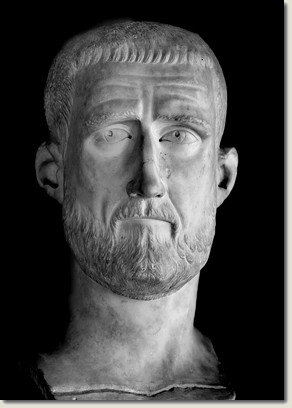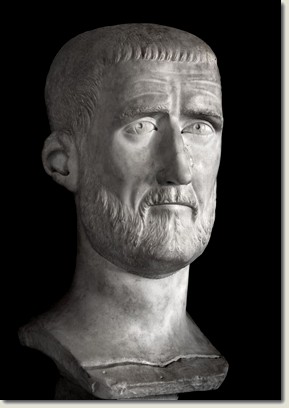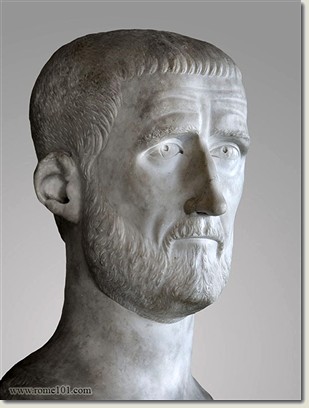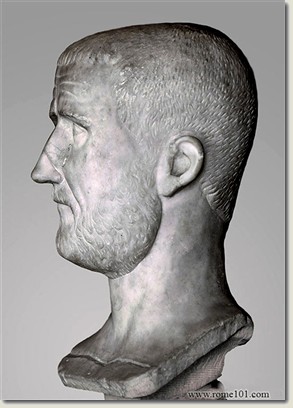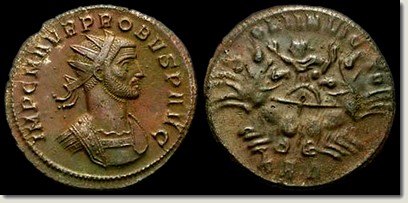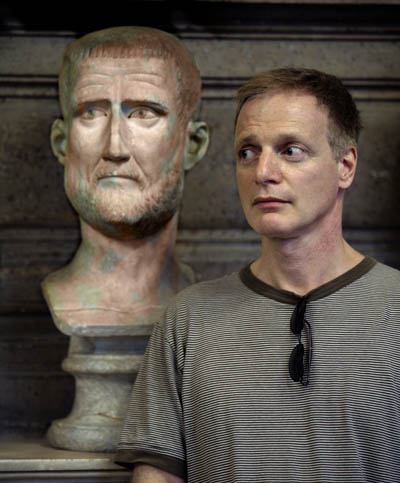
Up to Imperial Portraits
Probus was
Preceded by Florianus
Succeeded by Carus
Email us about this page
This marble head, larger than life-size (45 cm high), in the Capitoline Museum, Hall of the Emperors, has been identified by Fittschen, Zanker and others as emperor Probus (probably Marcus Aurelius Probus Augustus) who reigned 276‑282 CE.
The anonymous Historia Augusta, known to be extremely unreliable, has this to say about Probus:
| Now we must take up Probus, a man of note both at home and abroad, and one to be preferred to Aurelian, to Trajan, to Hadrian, to the Antonines, to Alexander, and to Claudius, for the reason that, while they had various virtues, he had all combined and to a surpassing degree. He was made emperor after Tacitus by the vote of all good men, and he ruled a world to which he had brought perfect peace by destroying barbarian tribes and by destroying also the very many pretenders who arose in his time, and about him it was said that he was worthy to be called Probus ["upright"] even if that had not been his name. |
Aurelius Victor, in De Caesaribus, written almost a century after Probus's death give Probus the highest praise possible. In a statement revealing as much about Rome's famed respect for their capable enemies as about his knowledge of Probus, adds:
| [Probus] was almost a second Hannibal because of his great knowledge of warfare and his versatile training of of the soldiers and toughening of the young recruits. For just as Hannibal considered the inactivity of his troops dangerous to the state and its leaders and filled many parts of Africa with olive trees through their labor, in the same manner he [Probus] filled Gaul, the Pannonians and the hills of Moesia with vineyards, naturally after he had crushed the barbarian tribes which had invaded when our emperors had been killed by the treacery of their own men. |
Zosimus, while praising Probus for "commendable action for the public good", allows the possibility that Probus might have had a hand in the murder of his predecessor, Florianus:
| A universal civil disturbance now arose, those of the east choosing Probus emperor, and those at Rome Florianus. [...] it came to pass, that the weather, being exceedingly hot, a pestilential disorder broke out amongst the troops of Florianus, most of whom were Europeans, and consequently unaccustomed to such excessive heat, by which many were taken off. When Probus understood this, he thought it a proper time to attack the enemy. The soldiers of Florianus, attempting what exceeded their strength, fought some slight skirmishes before the city, but nothing being done worthy of notice, some of the troops of Probus deposed Florianus. Having performed this, he was kept in custody for some time, until his own soldiers said, that it was the will of Probus that he should share the empire. Florianus therefore assumed the purple robe again, until the return of those who were sent to know the true resolution of Probus. On their arrival they caused Florianus to be killed by his own soldiers. |
Six years later, Probus was killed by his own troops, for reasons that we cannot know for certain. History of the mid to late 3rd century is particularly difficult to reconstruct, given that the few primary sources are unreliable and largely interdependent. For example, the Historia Augusta, Aurelius Victor (both cited above) and Eutropius can be shown to be dependent on the same now-lost source, which itself must have contained gross errors.
It is difficult to reconcile the
ruthlessly efficient and wise Probus of the above-cited ancient
literature with what we today see as a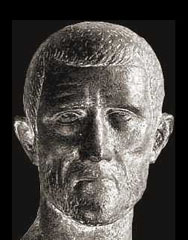 spiritual, reserved, and somewhat unconfident subject of this portrait. The
portrait is similar in artistic style and facial proportions to the
bronze head in Brescia, generally accepted as representing Aurelian (at
right). The coiffures of the two portraits are similar but not identical
- Aurelian showing recession of his hairline on his right side. Both
portraits show identical nasolabial folds, forehead wrinkles and oral
comissures. The marble head (below) shows a higher degree of
abstraction of the sort seen in late Gallienic portraits than the bronze
(Aurelian) head. If the identities of the two portraits are accepted, it
is possible that Probuus's portrait looks more like that of Aurelian
than the case may have been in real life - as was common in portraiture
where their was propaganda value in reminding viewers of a connection
between the current emperor and a respected predecessor.
spiritual, reserved, and somewhat unconfident subject of this portrait. The
portrait is similar in artistic style and facial proportions to the
bronze head in Brescia, generally accepted as representing Aurelian (at
right). The coiffures of the two portraits are similar but not identical
- Aurelian showing recession of his hairline on his right side. Both
portraits show identical nasolabial folds, forehead wrinkles and oral
comissures. The marble head (below) shows a higher degree of
abstraction of the sort seen in late Gallienic portraits than the bronze
(Aurelian) head. If the identities of the two portraits are accepted, it
is possible that Probuus's portrait looks more like that of Aurelian
than the case may have been in real life - as was common in portraiture
where their was propaganda value in reminding viewers of a connection
between the current emperor and a respected predecessor.
Numismatic portraits, which are all profiles, of Probus show a slightly more rectangular head in profile than that of Aurelian. On this basis the considerably more rectangular marble head shown here might be accepted as Probus and the other as Aurelian. This is shaky ground for sure, and we think neither identification can be accepted with certainty. Third century eclecticism and regional differences in artistic styling could easily account for both portraits representing either one of the emperors; or we could have them reversed - or worse.
